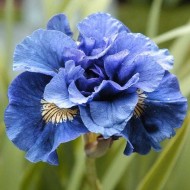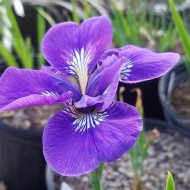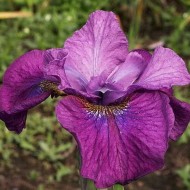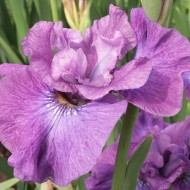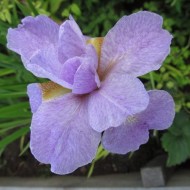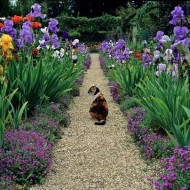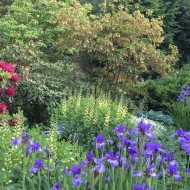Secrets of growing and using Siberian iris in garden design
Content
Description and distribution of Siberian iris
Siberian iris is a perennial rhizome herb, one of the species of the same genus, belonging to the Iris family. In nature, it is capable of reaching a height of 1.5 m and above, but hybrid forms usually do not exceed 80 cm.
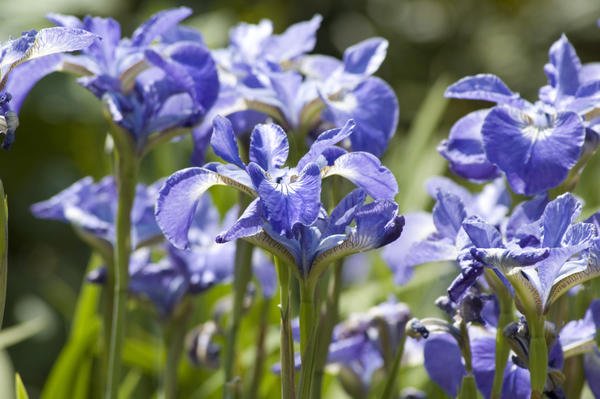
Siberian varieties have no beard. Plants have a fleshy creeping rhizome, giving many shoots. Their stems are strong, branched at the top. The leaves are long (40-80 cm), xiphoid, with a linear surface, green, and in some varieties, grayish.
Peduncles are formed at the top of the stem in several pieces. The classic flower has 6 petals, of which the lower 3 are wider, brighter in color and curved downward. The middle petals are narrow, monochromatic and curved upward. The natural color of the flower is blue or bluish, hybrids have a variety of shades. Siberians bloom in May. Despite the name, they grow almost everywhere, at least on the European continent.
The rhizome of the plant is a valuable medicinal raw material. It contains unique essential oils and components used in traditional medicine.
Video "Reproduction of Siberian iris"
In this video, the expert will share recommendations for breeding Siberian iris.
Varietal variety
We offer a description of several of the most beautiful varieties:
- Kita no Seiza is a Japanese hybrid with large mauve buds. Terry petals, have a yellow spot at the base. Seiza tolerates partial shade, drought and severe frosts, but does not tolerate waterlogging.
- Pink Parfait is a charming lavender flower with lightened edges and a yellow center. Attracts many double and slightly corrugated petals (about 18 pieces), blooms in June.
- Kaboom is an unusually bright double variety. The flowers are large (up to 14 cm), consisting of 9-12 wavy petals of deep purple-blue color with a light base. The variety blooms from May to the end of June.
- Sia Leiter is a bright flower with a rich violet-purple color. The petals are wide, slightly wavy, on the lower ones there is a light spot and a small dark mesh.
- IC Stars is a hardy variety with medium flowering times (June-July). The flowers are six-petaled, eye-catching with a deep cornflower blue color and a contrasting light spot in the middle. The petals are almost not bent, which makes the flower look like a star.
- Concord Crash is a large-flowered (up to 15 cm) hybrid with double purple-blue buds. The petals are wavy, at the base they have a yellowish spot bordered by a dark mesh.
- Miss Apple is a vibrant Dutch hybrid with colorful buds. The flower is simple, but due to the wide wavy petals it seems very lush.The color of the lower petals is burgundy-purple with a yellow spot at the base. The inner petals are purple.
- Miss Apple is a flamboyant Dutch hybrid
- Concord Crash - large-flowered (up to 15 cm) hybrid
- IC Stars is a hardy variety with medium flowering times
- Sia Leiter - a bright flower of a rich violet-purple color
- Kaboom is an unusually bright double variety
- Pink Parfait
- Kita no Seiza
The advantages and disadvantages of culture
- high winter hardiness (up to –40 ° C) and drought resistance;
- good immunity to disease;
- variety of varieties and colors;
- intensive growth;
- long period of life and flowering;
- endurance and ability to bloom in harsh conditions.
- moisture intolerance;
- exactingness to lighting.
Planting and grooming recommendations
Agricultural technology of Siberian varieties does not differ much from other groups and types of irises.
Choosing a site for a flower garden
The main requirement for the location of the flower garden is a sunny, windless area. Penumbra will work too, but bloom will start later and will not be as lush. The most suitable soil is loose loam with neutral acidity. You should not plant irises in swampy areas with a close occurrence of groundwater, since waterlogging has a bad effect on the development of plants.Landing dates and rules
Planting "Siberians" is carried out in May or at the very end of summer, but no later than mid-September. Having decided on the site, the soil must be dug up, cleaned of debris, and wells must be prepared so that the roots are placed freely.
At the bottom of the hole, you can put a little compost, sawdust. The seedling should be placed vertically, covered with earth, the soil should be compacted, watered abundantly and sprinkled with mulch for better rooting. When planting several bushes, the recommended distance is 60-70 cm between them.
Reproduction and transplantation
Flowers reproduce by dividing the rhizome. The procedure is performed no earlier than a month after flowering. To divide the rhizome, the bush is cut off, then dug up and divided into parts so that each has 3-8 fan-shaped shoots. For reproduction, only the young parts of the root are cut off, the old ones are thrown away. Siberian species can grow in one place for tens of years, but so that they do not degenerate, division and transplantation are recommended every 6-7 years.

Watering and nutrition
Classic "Siberians" can live without watering, but hybrids still need to be watered. Moisten the culture infrequently, only in dry periods. You also need to cut off wilted buds in a timely manner. Abundant flowering is achieved by dressing, which are applied three times per season:
- in the spring - humus;
- during the laying of buds - a mineral-organic complex or compost, herbal infusion;
- after flowering - potassium and phosphorus.
Siberian irises care in autumn
It is not necessary to insulate the flowers, it is enough just to cover the bare roots with earth and cover with a small layer of mulch. Shortly before the first frost, dried leaves must be cut to a height of 10 cm.
How to protect irises from diseases and pests
Flowers are able to resist disease, but during periods of high humidity, their leaves can turn yellow and rusty. In the first case, the bushes should be treated with a 1% solution of colloidal sulfur. A 0.5% solution of copper oxychloride is effective against rust. Sometimes thrips or caterpillars can settle on the leaves. Tincture of tobacco, soap solution helps to get rid of them. In advanced cases, insecticides are used.
Siberian iris in landscape design
The use of Siberian species in landscape design is universal. Bright large flowers look equally good:
- in rocky gardens, alpine hills;
- near buildings and fences;
- along the paths and at the central entrance;
- near bodies of water;
- as a border;
- against the background of a green lawn.
- Siberian irises look good by water
- Irises can be planted along paths and at the main entrance
- You can plant "Siberians" both separately and as part of compositions
You can plant "Siberians" both separately and as part of compositions. They go well with lilies, peonies. The violet-blue palette is favorably shaded with yellow, white, pinkish colors. The advantage of plants is that, even after flowering, they decorate the area with their unfading foliage.
The Iris sibirica flower is the most hardy and practical of its kind. It is ideal for filling a space with beautiful flowers when there is no time to care for them. Bulk plantings themselves will grow every year, saturating your garden with bright colors.


